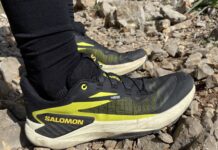
Disclaimer: I’m a Saucony shoe fan, and the original Zealots were my go-to choice for most races that were over 10km. I already had high expectations for the Zealot Iso 2s before I even took them out of the box.
I was a tad surprised to see Saucony sent us over a pair of black and white shoes since most of their lineups have crazy colors.
The color surprise faded as I slipped into the shoes and planned a set of runs to put these shoes up to 50 miles so I could figure out how they compared to the previous model.
Saucony Zealot ISO 2 General Info
The Saucony Zealot continues as a go-to replacement for the Cortana line because of the Zealot’s similar 4mm drop and lightweight package.
Slipping into these shoes for the first time feels more like getting into a sleeve or bootie due to the wrap-around coverage that the upper has with an integrated tongue.

Saucony Zealot ISO 2 – Inner
Once you get comfortable lacing them up with the external ‘cage’ holding your midfoot in place, you’ll immediately notice some extra cushioning going on in the sole thanks to the POWERGRID+ and EVERUN foams.
Although the Iso 2 is 1.2 ounces heavier than the predecessor, it’s still a lightweight shoe at 9.5 ounces. It took me a few runs to fine tune the lacing system so everything felt right, but it was worth it to get the correct fit.
Saucony Zealot ISO 2 Sole Unit
Saucony uses the industry standard arrangement of durable carbon rubber around the toe and heel of the shoe, and high cushioning blown rubber around the midsection of the sole.

Saucony Zealot ISO 2 – Sole
They upgraded the Zealot Iso 2’s sole to their new Tri-Flex design which is found on many of their other new models.
This Tri-Flex design allows the shoe to flex evenly under the toebox, and keeps a large amount of rubber in contact with the road as you run.
It’s getting rarer to find lightweight trainers with ample amounts of rubber, but Saucony treats you with the full package in these shoes.
I reached 400+ miles in the previous model without wearing through the outsole, and expect the same durability out of this newer model.
The biggest change to the sole in the Zealot Iso 2s is the use of EVERUN in a thin layer just beneath the insole. This EVERUN material claims to have 83% energy return, and be 3x more durable than EVA foam.
It does feel like a good foam, just don’t call it a miracle material. I’d compare feel and ride of EVERUN foam to Adidas’ Boost Foam (they even look similar with their grid of white pellets).
Keep in mind that the use of EVERUN doesn’t make this shoe a stability shoe, it’s still just a neutral shoe. If you want more support, go for the Omni, the Xodus or the Redeemer line.
Below the EVERUN foam is Saucony’s Powergrid+ cushioning system that provides 20% more cushioning than standard midsoles.
The collective experience with all these different foams in the sole leaves you with a moderately supportive and cushy ride.
Just be aware that although this shoe has a low drop of just 4mm, the shoe isn’t super flexible since the drop comes from a heel stack height of 26mm and a forefoot stack of 22mm.
Saucony Zealot ISO 2 Upper Info
The Zealot Iso 2 has quite a playful upper. It features “ISOFIT”, which is more like a continuous sleeve instead of an upper and a tongue that you slip your foot into.
This integration of the tongue into the upper smooths up the fit, but will create extra bunching if you tighten the shoe up a lot.

Saucony Zealot ISO 2 – Lateral Side
I found this sleeve compliments the cushioned sole by creating an enveloping comfortable and cushioned ride. The external support cage adds keeps your midfoot in place without restricting too much movement.
I think Saucony could tune in this support cage a little more by removing some material, since it buckles outward in a few areas when making a snug fit.
The Saucony Hurricane Iso 2 shoes have similar overlays, and I mentioned other companies are managing the same tight feel without the bulky overlays.
Adidas has the thin rubberized overlays going to their laces on the Ultra Boost shoes, Nike has Flyknit which uses strings to keep everything tight, but Saucony has large synthetic cutouts that reduce breathability, add weight, and crumple up if you really tighten the shoes.
The rest of the upper uses FlexFilm overlays to add strength without much extra weight. Saucony used extra FlexFilm around the toebox compared to the previous model.
This extra FlexFilm is a welcomed addition in my opinion since the toebox was the first part to fail on the previous model when I pushed the shoe past 400 miles.
The fabric used in the tongue is a different material from the rest of the mesh, and uses a denser material to reduce pressure points on the top of the foot as you tighten the overlays in your midfoot using the slightly stretchy laces.
Saucony Zealot ISO 2 Conclusions
The original Zealot Iso shoe was a major success, getting high reviews from runners who could not find many flaws with the shoe.
I think the Zealot Iso 2s improve slightly on the first generation Zealot Iso shoes with the addition of EVERUN foam, but the 1.2 ounce weight addition might dissuade particularly picky runners.

Saucony Zealot ISO 2 – Heel
Since the upper remained almost the same, I would recommend runners try out last year’s model in addition to the current model so they can determine if the the addition of EVERUN is worth the extra cost.
We thank the nice people at Saucony for sending us a pair of Zealot ISO 2 to test. This did not influence the outcome of the review, written after running more than 50 miles in them.



























